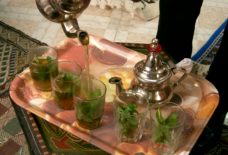Cleveland's Syrian Garden Tells Story of Cultural Contributions, Tolerance and Diversity
The tumult in the homeland was carefully acknowledged at the dedication of Cleveland’s Syrian Cultural Garden today.
But the many symbolic nods to the culture’s contributions to all of civilization gave glimmers of hope to its diverse group of Cleveland descendants for future peace.
Six granite pedestals, inscribed with a narrative history of Syria from past to present, include shared points of pride, like creation of the first alphabet.
“For most of its history, Syria has been an exemplary place for religious, ethnic and cultural diversity and tolerance,” read one particular passage, a comforting reminder amid the current conflict.
Perhaps the most notable element in the garden — and one likely to become a breathtaking backdrop for many a wedding portrait — is the Syrian-style arches, an ode to the Palmyra Arch of Triumph, which rise out of the desert in Palmrya, Syria.
The plot for the Syrian Garden, across Martin Luther King Jr. Boulevard from the Indian garden’s towering bronze statue of Mahatma Gandhi, was bestowed on the community more than 80 years ago.
Northeast Ohio’s Syrian community, estimated at several thousand people, traces its origins to a Greater Syria that once included Lebanon.
The gardens pay homage to that connection with snippets of messages from famous Lebanese-American poet Khalil Gibran’s message “To Young Americans of Syrian Origin.”
“I believe that you have inherited from your forefathers an ancient dream, a song, a prophecy, which you can proudly lay as a gift of gratitude upon the lap of America,” the message says.
Syrian-Americans who live here are as likely to be Christian as Muslim. Some of the community’s earliest immigrants came from Ottoman Syria in the 1880s. Another wave arrived in the 1960s when there was unrest in the Middle East.
For the last three years a group of dedicated men and women donated “time, talent and treasure” to assure the immigrant community would have its place among the 26 others represented there, said Adnan Mourany, president of the Syrian Cultural Gardens Association Executive Committee.
But as the dedication came closer, protests flared in Syria and President Bashar Assad sent tanks and soldiers into cities. About 1,000 people have been killed in the last several months.
A throng of current and former politicians gathered to congratulate the group on being the first Arab-American community to join one of the city’s cultural gems. Former Congresswoman Mary Rose Oakar, said she wished her parents, who were of Lebanese and Syrian ancestry, could be present to see the garden.
Today, Oakar said, “We renew our love for America, for Cleveland and for our roots.”
U.S. Rep. Dennis Kucinich, an ardent supporter who has visited Syria, drew a burst of applause when he dubbed the garden “a celebration of humanity and human unity.”
Nasser Rabbat, Massachusetts Institute of Technology Professor of Islamic Architecture, explained that the grand tiers of stairs that lead down into the garden symbolize history cascading from the past and coming down through the arches into the present, where the garden blooms with Damascus roses.
An Arabic-style fountain, common in many Syrian homes and courtyards is the centerpiece of a 16-point star — in homage to the importance of geometry as art.
The garden is hugged by three amphitheater-style steps that Rabbat said represent people sitting together and making decisions: “Hopefully for the future, too.”
A group of schoolchildren from the New Horizon School in Westlake stood on those steps waving and singing as their parents and grandparents clapped along to a traditional song, with a refrain that roughly translates to “bless the beloved land of Syria.”
Amr Al-Azm, an archeologist who is an associate professor of history from Shawnee State University, told the crowd he was doing some soul-searching on his drive up from Portsmouth about what the future of Syria will hold. Syria, he said, acted as a crucible for the formation of other civilizations. Its cities are uniquely characterized by harmony between new and old Muslims and Christians, Arabs and non-Arabs, locals and internationals.
Al-Azm said he hopes that those ideas will be a beacon for those in Syria now that “a new freer Syria emerges from these trying times.”
<center><object id=”flashObj” width=”486″ height=”412″ classid=”clsid:D27CDB6E-AE6D-11cf-96B8-444553540000″ codebase=”http://download.macromedia.com/pub/shockwave/cabs/flash/swflash.cab#version=9,0,47,0″><param name=”movie” value=”http://c.brightcove.com/services/viewer/federated_f9?isVid=1″ /><param name=”bgcolor” value=”#FFFFFF” /><param name=”flashVars” value=”videoId=966498695001&playerID=649725534001&playerKey=AQ~~,AAAAQBxUNqE~,xKBGzTdiYSTvTgY_KEDQxGs6uqT6UiMm&domain=embed&dynamicStreaming=true” /><param name=”base” value=”http://admin.brightcove.com” /><param name=”seamlesstabbing” value=”false” /><param name=”allowFullScreen” value=”true” /><param name=”swLiveConnect” value=”true” /><param name=”allowScriptAccess” value=”always” /><embed src=”http://c.brightcove.com/services/viewer/federated_f9?isVid=1″ bgcolor=”#FFFFFF” flashVars=”videoId=966498695001&playerID=649725534001&playerKey=AQ~~,AAAAQBxUNqE~,xKBGzTdiYSTvTgY_KEDQxGs6uqT6UiMm&domain=embed&dynamicStreaming=true” base=”http://admin.brightcove.com” name=”flashObj” width=”486″ height=”412″ seamlesstabbing=”false” type=”application/x-shockwave-flash” allowFullScreen=”true” swLiveConnect=”true” allowScriptAccess=”always” pluginspage=”http://www.macromedia.com/shockwave/download/index.cgi?P1_Prod_Version=ShockwaveFlash”></embed></object></center>
Rachel Dissell
Cleveland


